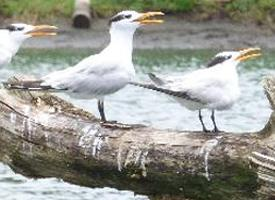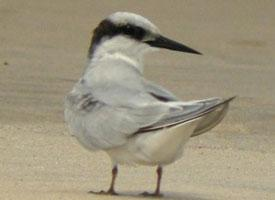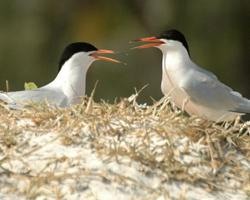
Statut de conservation
| Menacé |
Description de l'animal
The Royal Tern (Thalasseus maximus) is a striking and majestic seabird, a member of the tern family, that graces many coastlines and estuaries around the world with its presence. With its streamlined body, long pointed wings, and forked tail, this bird is an exceptional flier, capable of impressive aerial maneuvers as it hunts for fish. The Royal Tern is distinguished by its large size, with a body length ranging from 45 to 50 cm (18 to 20 inches), and a wingspan that can reach up to 130 cm (51 inches), making it one of the larger tern species.One of the most distinctive features of the Royal Tern is its bright orange-red bill, which is long, thin, and sharply pointed, perfect for plunging into the water to catch prey. Its head is adorned with a sleek, black cap during the breeding season, which contrasts strikingly with its white forehead, cheeks, and underparts. Outside of the breeding season, the black cap becomes patchy, revealing more of the white plumage beneath. The bird's back and upperwings are a pale grey, providing camouflage against the sea from above, while its deeply forked tail aids in its agile flight.
Royal Terns are found along many of the world's temperate and tropical coastlines, including the Atlantic and Pacific coasts of North America, the Caribbean, and the west coast of Africa. They are highly migratory, with birds breeding in North America typically wintering in South America, and those from European and African colonies moving southwards after the breeding season.
The breeding habits of the Royal Tern are as fascinating as their appearance. They nest in large, dense colonies on sandy or gravelly beaches and islands, often alongside other seabirds. Both parents take part in constructing the nest, which is usually a simple scrape in the ground. The female typically lays one, rarely two, eggs, which both parents then incubate. Once hatched, the chicks are semi-precocial, meaning they are born with their eyes open and covered in down but remain dependent on their parents for food and protection.
Royal Terns feed primarily on fish, which they catch by performing spectacular dives from the air into the water. They are also known to eat crustaceans and insects. Their hunting technique involves flying over the water to spot their prey before plunging in, often emerging with a fish crosswise in their beak. They then return to the air, adjust the fish headfirst, and swallow it whole.
Social and vocal, Royal Terns often gather in large flocks during both the breeding and non-breeding seasons. Their calls are a loud, harsh "kree" or "kee-arr," which can be heard over the sound of the waves and wind along the coastlines where they live.
Conservation efforts are ongoing to ensure the protection of Royal Tern habitats from human disturbances and the effects of climate change, such as sea-level rise and increased storm frequency, which pose significant threats to their nesting sites. While currently listed as of Least Concern by the International Union for Conservation of Nature (IUCN), the Royal Tern's dependence on specific coastal environments for breeding and feeding makes its well-being a good indicator of the health of marine ecosystems.
In summary, the Royal Tern is a remarkable bird, both in appearance and behavior. Its presence along the world's coastlines adds to the biodiversity and beauty of these environments, making it a cherished species among birdwatchers and conservationists alike.
Animaux similaires
Nouvelles photos d'animaux
Top 10 des animaux
- Dolphin gull (Leucophaeus scoresbii)
- Diana monkey (Cercopithecus diana)
- Moustached guenon (Cercopithecus cephus)
- Galápagos tortoise (Geochelone nigra complex)
- Japanese macaque (Macaca fuscata)
- Stone loach (Barbatula barbatula)
- Russian tortoise (Testudo horsfieldii)
- Greek tortoise (Testudo graeca)
- Common flying dragon (Draco volans)
- Vendace (Coregonus albula)


